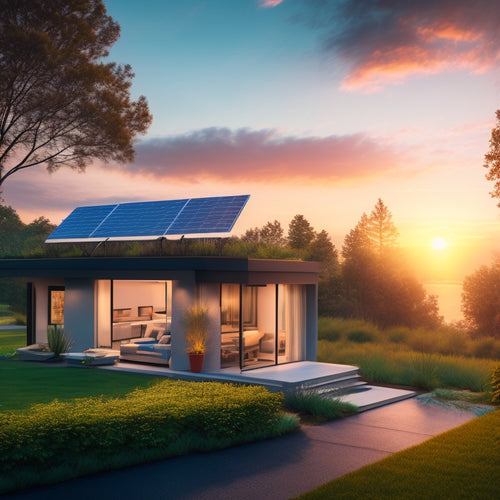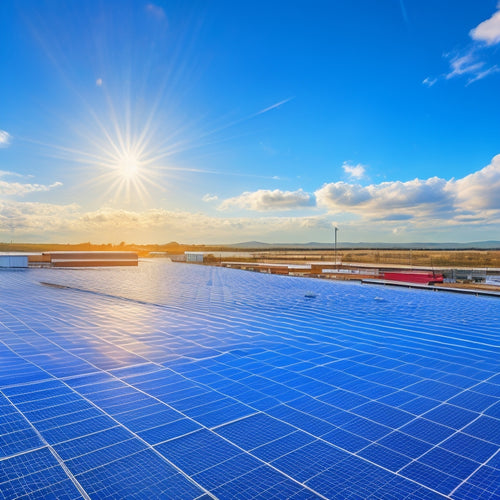
Solar Panel Mounting Brackets for Efficient Energy Harvesting
Share
When selecting solar panel mounting brackets for efficient energy harvesting, focus on durability, material strength, and adaptability. You'll want brackets made from corrosion-resistant materials like stainless steel or aluminum, especially in harsh environments. Guarantee they can withstand extreme weather conditions and high winds by choosing designs with good aerodynamics and sturdy anchoring. Adjustable angles allow panels to capture maximum sunlight throughout the day. Additionally, consider your roof type, as this impacts installation and efficiency. The right brackets streamline the installation process and improve overall energy output. There's more to uncover about optimizing your solar energy system for the best results.
At a Glance
- Selecting durable materials like stainless steel or aluminum ensures longevity and resistance to bending, corrosion, and extreme weather conditions.
- Adjustable mounting brackets allow for optimal angle positioning, maximizing sunlight exposure and energy conversion efficiency throughout the day.
- Proper wind resistance capabilities, including aerodynamic designs and anchoring techniques, enhance stability and protect solar panels during high winds.
- Conducting shading analysis and customizing bracket placement minimizes obstructions, further improving sunlight access and overall energy output.
- Understanding roof type distinctions helps in selecting appropriate mounting solutions, ensuring effective and durable solar panel installations.
Durability in Extreme Weather
When selecting solar panel mounting brackets, you must consider material strength to guarantee they withstand extreme weather conditions.
High-quality materials not only enhance durability but also improve wind resistance capabilities, which is essential in storm-prone areas.
Additionally, choosing reliable racks can support consistent energy generation and minimize the need for maintenance.
Evaluating these factors will help you choose brackets that maintain structural integrity and protect your solar investment.
Material Strength Considerations
In extreme weather conditions, the durability of solar panel mounting brackets hinges on their material strength. You'll want to choose materials that not only withstand high loads but also distribute those loads effectively across the mounting system. This guarantees that the brackets maintain their integrity under pressure from heavy snow or ice accumulation, as well as from intense rainfall.
Corrosion resistance is another critical factor. Brackets made from stainless steel, aluminum, or treated materials can greatly enhance longevity, especially in coastal areas where salt exposure is common. Selecting corrosion-resistant materials helps prevent degradation over time, which directly impacts their ability to support solar panels effectively.
Additionally, consider the thickness and design of the brackets. Thicker materials often provide better resistance to bending and deformation, assuring that your solar panels remain securely in place.
You're investing in your energy independence, so prioritize materials that can endure the elements and support peak energy harvesting. By making these informed choices, you can achieve not only safety and durability but also the freedom to utilize renewable energy without frequent maintenance or replacement concerns.
Wind Resistance Capabilities
Material strength plays an essential role in how well solar panel mounting brackets can withstand extreme weather conditions, particularly high winds. When choosing brackets, consider those engineered with high tensile materials that maintain their structural integrity during turbulent weather. This durability is crucial for ensuring your system's longevity and efficiency.
An aerodynamic design is equally important. Brackets shaped to reduce wind resistance help minimize uplift forces that could otherwise destabilize your panels. By optimizing the bracket's profile, you enhance its ability to handle gusts without compromising the overall system.
Additionally, effective installation techniques that incorporate proper anchoring can further increase wind resistance. Ensuring that brackets are securely fastened to the mounting surface will mitigate the risks associated with extreme weather.
Ultimately, selecting mounting brackets that excel in both material strength and aerodynamic design enables you to utilize solar energy freely, even in challenging conditions. Investing in quality components means you're not just protecting your investment but also ensuring that your energy independence remains intact, regardless of the weather.
Choose wisely, and let your solar system thrive amidst the elements.
Increased Energy Conversion Efficiency
To maximize energy conversion efficiency, you need to guarantee your solar panels are positioned at the ideal angle.
By adjusting the angle, you can markedly enhance sunlight exposure throughout the day. This strategic alignment directly influences the overall performance and energy output of your solar system.
Additionally, using high-efficiency solar panels can further improve energy harvesting, as they convert more sunlight into usable power.
Selecting the right solar panel configuration is essential for achieving the best results in energy production.
Optimal Angle Adjustment
Adjusting the angle of solar panels greatly improves energy conversion efficiency. By implementing angle refinement, you can guarantee that your panels capture the maximum amount of sunlight throughout the day. The principle behind this is simple: solar panels generate the most energy when they're perpendicular to the sun's rays.
To achieve this ideal angle, many solar systems now incorporate solar tracking technology. These advanced systems automatically adjust the panels' orientation to follow the sun's path, allowing for a significant increase in energy output compared to fixed installations.
You'll find that using solar tracking can enhance efficiency by up to 25%, depending on your location and the specific technology used.
It's crucial to take into account the geographical factors and seasonal changes when determining the best angle for your solar panels. Regularly adjusting the angle to align with the sun's position not only improves energy capture but also prolongs the lifespan of your panels.
Ultimately, adopting ideal angle adjustments through solar tracking will enable you to utilize renewable energy more effectively, providing both energy independence and cost savings over time.
Enhanced Sunlight Exposure
Maximizing sunlight exposure is essential for increasing energy conversion efficiency in solar panel systems. To achieve this, you should consider implementing sunlight tracking systems. These advanced mounting brackets adjust the angle of your solar panels throughout the day, ensuring they capture the maximum amount of solar radiation. By actively following the sun's path across the sky, you can markedly enhance energy yield compared to fixed systems.
In addition to tracking, shade reduction is important. Even minimal shading can dramatically decrease the performance of solar panels, so it's imperative to position your panels away from obstructions like trees, buildings, or other structures that might cast shadows.
Using mounting brackets that allow for customizable placement can help you optimize your site layout, ensuring that your panels remain in the sun's direct path.
Moreover, consider using reflective materials or coatings on nearby surfaces to enhance light availability. This approach can further elevate energy conversion efficiency by redirecting additional sunlight to your panels.
Mounting Angle Adjustability
Adjustable mounting angles greatly enhance the efficiency of solar panels by allowing you to refine their positioning relative to the sun's path.
By employing ideal positioning techniques, you can maximize energy capture throughout the day and across seasons.
Additionally, selecting the right solar battery storage system, such as high-capacity deep cycle batteries, is essential for storing excess energy generated during peak sunlight hours.
Understanding how to effectively adjust these angles is vital for achieving the best performance from your solar installation.
Benefits of Adjustable Angles
Utilizing mounting brackets that allow for angle adjustments can considerably enhance the efficiency of solar panel systems. By enabling you to optimize the panel's tilt according to seasonal variations and local weather conditions, these adjustable brackets lead to significant energy savings.
For instance, during summer, you might angle your panels to capture more direct sunlight, while in winter, a steeper angle could help mitigate snow accumulation, ensuring maximum exposure to sunlight throughout the year.
Moreover, installation flexibility is an essential benefit of adjustable angle brackets. Whether you're retrofitting an existing system or installing a new array, these brackets adapt to your specific needs and site conditions.
You won't be confined to a fixed installation; instead, you can position your panels for peak performance based on real-time data and environmental factors.
Optimal Positioning Techniques
How can you guarantee your solar panels achieve peak performance throughout the year? One effective strategy is to employ mounting brackets that allow for angle adjustability. By enhancing the tilt and orientation of your panels, you can greatly improve energy capture.
Conducting a shading analysis is vital; it helps you identify potential obstructions that could reduce sunlight exposure.
Seasonal adjustments are equally important. The sun's position changes throughout the year, so modifying the angle of your panels according to seasonal variations maximizes their efficiency. In summer, a flatter angle is generally more effective, while steeper angles in winter can help capture the lower sun.
Investing in adjustable mounting brackets enables you to adapt to these changing conditions seamlessly. It gives you the ability to take control of your energy production, reflecting a commitment to independence.
Selecting Based on Roof Type
When selecting solar panel mounting brackets, you must consider your roof type for ideal installation.
Flat roofs require specific solutions, such as ballasted or penetrative systems, which can accommodate the unique challenges presented by these surfaces.
On the other hand, sloped roofs can apply standard brackets for secure mounting, guaranteeing compliance with local building codes.
Understanding these distinctions will assure your solar panels are both effective and durable, allowing for customizable solar panel configurations.
Flat Roof Considerations
Considering the unique characteristics of flat roofs, selecting the right solar panel mounting brackets becomes crucial for maximizing efficiency and stability. Flat roofs offer distinct advantages, such as easier access for maintenance and the potential for ideal panel positioning.
However, you also face installation challenges, including wind loads and drainage considerations. When choosing brackets, you should prioritize systems that allow for proper drainage to prevent water pooling, which can compromise the integrity of both the roof and the mounting system.
Look for brackets designed specifically for flat roofs, as they often come with adjustable tilt options, enabling you to enhance solar exposure throughout the day. Additionally, consider the weight distribution of your solar array.
Brackets that distribute weight evenly help mitigate structural stress and guarantee long-term stability. You may also want to investigate ballasted systems that employ concrete blocks, as they can simplify installation without penetrating the roof membrane, reducing the risk of leaks.
Sloped Roof Solutions
For homeowners with sloped roofs, selecting the right solar panel mounting solutions requires careful consideration of the roof's pitch and material. The pitch influences the angle at which panels are installed, affecting their energy capture efficiency.
You'll want to refer to installation guidelines specific to your roof type to guarantee peak performance and safety.
When evaluating materials, consider whether your roof is asphalt shingle, tile, or metal. Each type has unique mounting requirements and aesthetic considerations.
For instance, tile roofs may need specialized brackets to prevent damage, while metal roofs often allow for direct attachment, minimizing visual impact.
Additionally, think about the overall aesthetics of your home. You might want to choose mounting solutions that blend seamlessly with your roofline, maintaining your home's visual appeal.
Low-profile mounts can help in achieving this goal while assuring the panels remain effective.
Ultimately, balancing efficient energy harvesting with aesthetic considerations is key. By following the correct installation guidelines customized to your specific roof type, you'll utilize solar energy effectively while preserving the beauty of your home.
Cost-Effective Installation Process
When planning your solar panel installation, consider simplified installation techniques to reduce labor costs and time.
By utilizing user-friendly mounting brackets, you can streamline the process and minimize complications.
This approach not only saves money but also enhances the overall efficiency of your solar setup.
Simplified Installation Techniques
Efficiency in solar panel installation hinges on adopting simplified techniques that streamline the process while minimizing costs. To achieve this, you should invest in the right installation tools, which can greatly reduce labor time and enhance precision. Quality tools, like power drills and torque wrenches, guarantee that brackets are securely fastened, preventing future issues.
User manuals are essential resources that provide detailed guidance on the installation process. They often include diagrams and step-by-step instructions customized to specific mounting systems, helping you avoid common pitfalls. Following these manuals closely allows for a more intuitive installation experience, saving you both time and frustration.
Moreover, consider pre-assembled mounting brackets. These options can cut down installation time, as they eliminate the need for complex assembly procedures on-site.
Frequently Asked Questions
What Materials Are Commonly Used for Solar Panel Mounting Brackets?
When considering mounting bracket types, you'll find aluminum and stainless steel are common materials. For successful bracket installation, guarantee proper alignment and secure fastening, maximizing durability while maintaining your system's efficiency and longevity.
How Do I Maintain My Solar Panel Mounting Brackets?
To maintain your mounting brackets, regularly check bracket alignment and verify they're securely fastened. Apply anti-corrosion treatments to prevent rust and inspect for wear, assuring peak performance and longevity for your solar energy system.
Can I Install Solar Panel Brackets Myself?
Absolutely, you can tackle DIY installation of solar panel brackets! Just remember, safety precautions are key. Double-check your tools, follow instructions closely, and you'll be on your way to utilizing energy with confidence.
What Is the Lifespan of Solar Panel Mounting Brackets?
The lifespan of solar panel mounting brackets typically ranges from 10 to 25 years, depending on bracket durability and installation techniques. Proper installation guarantees longevity, allowing you to maximize efficiency and enjoy sustainable energy for years.
Are There Specific Brands Known for Quality Mounting Brackets?
Did you know that over 80% of solar installations rely on quality mounting types? For durability, consider brands like IronRidge or Unirac. Follow expert installation tips to guarantee stability and maximize your system's efficiency.
Explore More
In the quest for ideal energy harvesting, you might think that fancy solar panels alone do the trick. Ironically, it's the often-overlooked mounting brackets that play an essential role in maximizing efficiency. By ensuring durability, adjustable angles, and compatibility with various roof types, these brackets become your unsung heroes. So, as you focus on those shiny solar cells, remember: the real secret to utilizing the sun's power lies in the sturdy, reliable brackets holding them in place.
Related Posts
-

The Future of Residential Energy Storage
The future of residential energy storage looks promising and cost-effective for you. With lithium-ion battery prices ...
-

Commercial Solar Energy
As you consider powering your business with commercial solar energy, you'll uncover it offers a triple benefit: signi...
-

Designing a Green Roof for Maximum Energy Efficiency
Designing a green roof for maximum energy efficiency involves several key strategies. Start by selecting native, drou...


